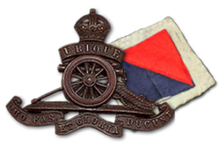1st Anti-Aircraft Division (United Kingdom)
| 1st Anti-Aircraft Division | |
|---|---|

Royal Artillery cap badge and AA patch
|
|
| Active | 15 December 1935 – 30 September 1942 |
| Country |
|
| Branch |
|
| Type | Anti-Aircraft Division |
| Role | Air Defence |
| Part of |
London District (1935–39) Anti-Aircraft Command (1939–40) 1 AA Corps (1940–42) |
| Engagements |
Battle of Britain The Blitz |
| Commanders | |
| Notable commanders |
Maj-Gen Sir Frederick Pile (1937–39) Maj-Gen Robert Whittaker (1940–41) |
The 1st Anti-Aircraft Division (1 AA Division) was an Air Defence formation of the British Army before and during the early years of World War II. It defended London during the Battle of Britain and The Blitz.
1st AA Division was organised on 15 December 1935 at Hillingdon House, RAF Uxbridge (at that time the headquarters of the Royal Observer Corps).
Responsible to London District but under the operational control of RAF Fighter Command, the Division's role was to command the growing number of Territorial Army (TA) anti-aircraft gun and searchlight units around London (2 AA Division was in formed in 1936 to cover the rest of the country). The headquarters of the division was formed by converting 47th (2nd London) Infantry Division, whose General Officer Commanding, Major-General R.H.D. Thomson, continued as GOC of the new formation. Thomson had been Commander TA Air Defence Brigades and Inspector of Regular AA Units, and thus already responsible for the four brigades or 'groups' that comprised the division. He also chaired the War Office committee on expansion and mobilisation of TA AA units, which sat from 1935 to 1937. Tompson was followed in 1937 by Maj-Gen Sir Frederick Pile, who was promoted in 1939 to command the whole of Anti-Aircraft Command.
1 AA Division was initially composed of the following formations and units:
(In 1938 the Royal Artillery replaced the unit designation 'Brigade' by 'Regiment', which allowed the AA Groups to take the more usual formation title of Brigades.)
The AA Divisions were unlike field formations: they were established to organise training and later exercise operational command in the static conditions of home defence, but relied entirely on the Home Forces commands for logistic support, supplies, and heavy repairs.
...
Wikipedia
